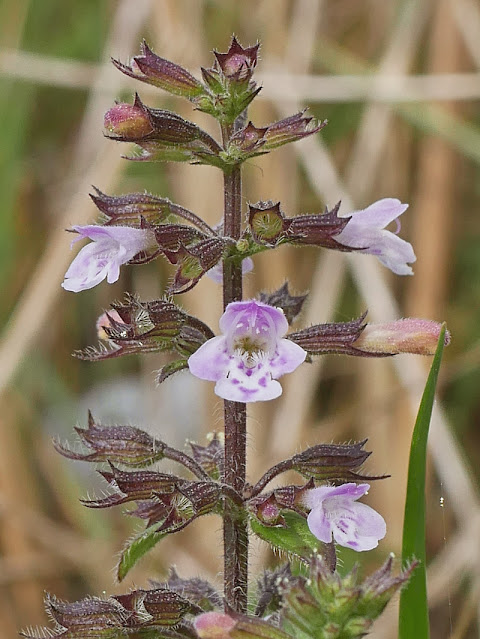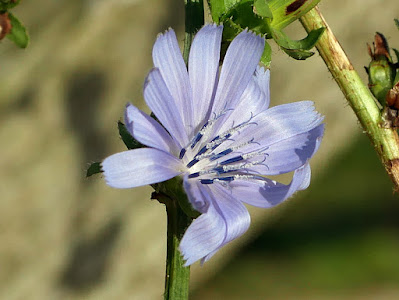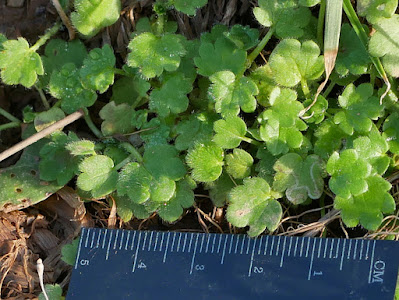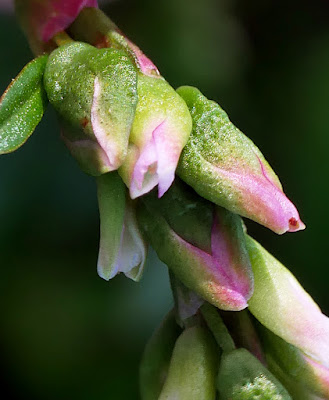It's stayed mild for the entire month which has encouraged the summer plants to continue flowering, such as Rough Chervil, but also has brought out many spring flowering species very early, such as Alexanders, flowering 23/10/24 at Pentireglaze). The plants below are just a few out of the many species that I found this month, I hope you enjoy the selection.
I started the month off with an afternoon walk around Rock Dunes. It is useful to be able to identify plants that are not in flower and I do so regularly. If I see a plant and can't identify it, I will give it a good try to put a name to it. One of the resources now available for this sort of botany is the Basal Plant Project, which has photos of young plants and rosettes of our native plants. By comparing your own photos of a plant to those on this site, you may get a match. I have contributed quite a few photos to the site, but it's focussed my mind on taking more non flowering photos to help teach others what some plants look like when not in flower. You can find this website at https://basalproject.org.uk/
Newly emergent leaves of Sea Bindweed at Rock Dunes - Calystegia soldanella
Car parks are often great places to find interesting plants and Rock was no exception. The sandy edges had a few Common Calamint flowering by the cars.
Clinopodium ascendens
Just outside the car park as a "weed" in an amenity planted enclosure was a stand of Cornish Ramping Fumitory, endemic to Cornwall. It's very rare East of the Rivel Camel so it was great to find some in Rock.
Fumaria occidentalis
I've been trying to identify any Eyebrights that I find this year, but some are so small it's impossible. This one was probably 2cm tall in heavily rabbit grazed coastal turf above Rock quarry. Th eonly way to identify it would be to pull it up in its entirety to examine the leaves and I wouldn't do that - plus, bear in mind it's illegal to uproot any plant without the landowners permission.
Euphrasia
I chose to go to Rock as I had found a solitary Knotted Pearlwort there two weeks before but only had my phone with me, and the photos I got from that were terrible. Fortunately, on this visit there were several more in flower in the same general area above Rock quarry. I'd previously only seen this species at Dungeness in Kent many years ago now. Note the "knotted" look of the leaves on the stems.
Sagina nodosa
There is huge population of naturalised Sweet Alison around Rock and its car park, but up to now I had only seen white flowered forms. The one below had two flower colours, white in the centre with lilac outer flowers, a quite striking plant.
Lobularia maritima
I took this photo as I thought the deep yellow of Cat's Ear blended perfectly with the red Cotoneaster fruits. It looks nice, but the Cotoneasters (probably C. simonsii) are becoming a problem here, taking over large areas of dunes with dense shrubby plants crowding out the smaller dune plants. It will need some sort of control soon, or plants such as Autumn Ladies Tresses and Knotted Pearlwort will disappear.
Hypochaeris radicata
Other interest included some yellow waxcaps and snails.
Striped or Banded Snail - Cernuella virgata
On a very rainy day, I saw that the weather would clear from the west early on in the day but stay wet for most of Cornwall, so I took the opportunity to look around parts of Sennen Cove and Gwynver Beach, about as far west as one can get without getting on a boat to Scilly. I was rewarded with a beautiful sunny day whilst the rest of Cornwall had rain and mizzle.
Sea Holly on the beach - Eryngium maritimum
A colourful composition including Sea Sandwort and Hottentot Fig, the latter being invasive. It stretched for over 30m in places along the beaches and really needs pulling up. Such are the problems we create when we bring foreign plants into the UK with no assessment at all on how they will affect our native plants and wildlife if they successfully escape gardens into the wild.
Honckenya peploides and Carpobrotus edulis
Borage is a fairly frequent garden escape over much of southern England. Habitation (or an allotment) is usually nearby. Bees really like these plants and along with the deep blue flowers, I can see why people like to plant them in their gardens. It readily escapes into the wild but causes no problems for other species.
Borago officinalis
It's always nice to find the pink striped version of Hedge Bindweed. I think it is absent from much of England, but it is more likely to be found in Cornwall, especially in the coastal west of the county. This one was found up a stream that drains into the middle part of Sennen Cove.
Calystegia sepium subsp roseata
Cyclamen or Sowbread was growing naturalised along a rural road verge, though not far from gardens from whence it likely originated. Here is a bee's eye view of the flower. This hangs down facing the ground, so we don't usually see it standing over the plant.
Cyclamen hederifolium
Perhaps the most unusual find of this trip was numerous patches of Purple Bugloss on the dunes at Sennen Cove. I had seen this plant before, but as an arable plant that thrived in a field edge in Kent, where previously sown many years before. It had not been previously recorded from Sennen Cove at all, with a single record in 2019 for Viper's Bugloss, which I think may have been mistaken for this species. I didn't find any Viper's Bugloss here.
On checking the county records, I saw that this species had been recorded 3km to the north of Sennen, so that is likely where it came from. It's an attractive plant, though somewhat rough to the touch. It's superficially like Viper's Bugloss, but the flowers are not blue with purple stamens and Vipers has 4 stamens emerging from the flower, whereas Purple Bugloss has just two. Much like Borage, bees love it too.
Echium plantagineum
It has been the worst year I have ever know for insects, with butterflies in particular noticable by their absence, so it was nice to find several butterflies this day, including Small Coppers and many Red Admirals.
A few days later I took a walk around the Mawgan Porth cliffs. There wasn't much to see on the cliffs themselves, but the arable fields just inland held plenty of interesting plants.
A strikingly deep pink Common Ramping Fumitory - Fumaria muralis
The lovely Corn Marigold - Glebionis segetum
Field Pansy - Viola arvensis
In the last week of October, I visited the Pentirglaze Farm area and found another interesting field full of nice species, like lots of Musk Thistles with their oversized purple flowerheads drooping down..
Carduus nutans
Chickory - Cichorium intybus
A "looking skywards" photo of the common Scarlet Pimpernel - Lysimachia arvensis
Two more rosette photos for you, found on almost bare rock by the sea. The tape measure shows how small these plants are at the moment.
The first is Birdsfoot - Ornithopus perpusillus
The next is Blinks - Montia fontana
An unusual find in the arable field was a patch of Hairy Buttercups. I usually find these on sandy clifftop turf; however, they are annual plants and will grow wherever favourable conditions allow, this fallow field being one such place. Unless it stays very mild, it is unlikely to flower until the spring.
Ranunculus sardous
A late summer plant I found here was Field Woundwort, quite uncommon over much of England
Stachys arvensis
You can't beat these views for botanising, here are The Rumps (left side headland) and The Moules (the island) from the walk at Pentireglaze Farm.
Corn Parsley is another easy to identify plant from a rosette, probable easier than when it is in flower. Note the pinnate form of the numerous basal leaves which tell it apart from Stone Parsley. In both species, by the time they are flowering, basal leaves have withered, making separating the two species trickier.
Sison segetum
The tiny flowers of Redshank. To easily separate this from Pale Persicaria, look at the ochrea (papery membranes along the stem below the leaves). In redshank, the ochrea has "eyelashes", in Pale Persicaria, they do not. There are other differences, but this is the easiest one to look for.
Persicaria maculosa
Below - the "eyelashes" on the ochrea of Redshank.
My final trip of October, was to Otterham in the north east of the county, with a stop at Davidstowe airfield to explore some recently felled pine plantation areas.
The first leaves of Lesser Celandine growing up through the mown grass in Otterham churchyard. This will flower in the spring, though last year I saw some flowering in November.
Ficaria verna
Royal Fern beginning to die back for the winter by the River Ottery.
Osmunda regalis
The drooping flowerheads of Water-pepper.
Persicaria hydropiper
It was nice to find some Lesser Trefoil flowering again, it's been a few months since I last found them flowering.
Trifolium dubium
The star find by the River Ottery was a stand of Devil's-bit Scabious, along with a Ragged Robin in flower (the photo of which unfortunately was blurred).
Succisa pratensis
At Davidstowe airfield there were hundreds of Toad Rush amongst the felled pine stumps, most in flower.
Juncus bufonius
Chamomile was frequent in the very short overgrazed parts of the airfield.
Chaemamelum nobile
Various stages of growth and decompostion of Shaggy Inkcap fungi at Davidstowe.
And finally, an oppportunistic Marsh yellowcress in a muddy tractor rut at Davidstowe.
Rorippa palustris
That wraps up October, I hope you liked the selection of plants. Keep a look out for rosettes over the coming months and see if you can identify them. Another useful tool is to be able to identify plants that are dead. It helps to look at plants as they transition from flower to seed to totally dead, as you then become familiar with them for much longer periods than just when they were in flower.
Take care
Dave


















































No comments:
Post a Comment
All comments are moderated before publication, so please don't bother spamming me, thank you. Genuine comments most welcome.